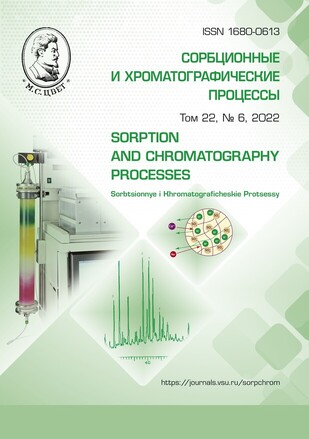Modification of the method for isolating miRNAs from plants phenol-chloroform extraction using polyethylene glycol 1500
Abstract
MicroRNAs are a class of small non-coding RNAs ranging in length from 18 to 25 nucleotides and found in most eukaryotic organisms. MicroRNAs can play an important role in epigenetic mechanisms of genome regulation, including DNA methylation, RNA and histone modification. Current methods for the detection and quantification of microRNAs are largely based on cloning, northern blotting, or primer extension, but each requires a pure preparation of the RNA type being analyzed. The standard RNA isolation method based on phenol-chloroform extraction with specific nucleic acid co-precipitants makes it possible to obtain preparations of total cellular RNA with a predominance of high-molecular types of ribonucleic acids. This greatly complicates the identification and quantification of miRNAs in sample preparations. Modification of the method of phenol-chloroform extraction of RNA, based on its precipitation of DNA with a specific precipitant, such as lithium chloride, showed that the use of polyethylene glycol 1500 with 2.5 M LiCl as a precipitant in the presence of 96% ethanol provides a high yield and high-quality microRNA extraction, which can be used for further analytical studies. PCR to assess the quality of the isolated microRNA with specific primers for miR165a showed the presence of one amplification product about 80 bp, which corresponds to the theoretical values calculated on the basis of the developed probe for this microRNA. A positive PCR result indicates the presence of the analyzed miRNA in the matrix used. Therefore, the use of a modified RNA isolation technique using polyethylene glycol 1500 (PEG 1500) as an element for the separation of high and low molecular weight nucleic acids made it possible to obtain miRNA preparations that can be used for further analytical studies.
Downloads
References
Chuang J.C., Jones Р.A Epigenetics and MicroRNAs. Pediatric Research. 2007; 61: 24-29.
Arif K.M.T., Elliott E.K., Haupt L.M., Griffiths L.R. Regulatory Mechanisms of Epigenetic miRNA Relationships in Human Cancer and Potential as Therapeutic Targets. Cancers (Basel). 2020; 12: 2922.
Yao Q., Chen Y. Zhou X. The roles of microRNAs in epigenetic regulation. Current Opinion in Chemical Biology. 2019; 51: 11-17.
He L., Hannon G.J. MicroRNAs: small RNAs with a big role in gene regulation. Nature Reviews Genetics. 2004; 5: 522-531.
Lagos-Quintana M., Rauhut R., Lendeckel W., Tuschl T. Identification of novel genes coding for small expressed RNAs. Science. 2001; 294: 853-858.
Zeng Y., Cullen B.R. Sequence requirements for micro RNA processing and function in human cells. RNA. 2003; 9: 112-123.
Krichevsky A.M., King K.S., Donahue C.P., Khrapko K., Kosik K.S. A microRNA array reveals extensive regulation of microRNAs during brain development. RNA. 2003; 9: 1274-1281.
Liu C.G., Calin G.A., Meloon B., Gamliel N., Sevignani C., Ferracin M., Dumitru C.D., Shimizu M., Zupo S., Dono M., Alder H., Bullrich F., Negrini M., Croce C.M. An oligonucleotide microchip for genome-wide microRNA profiling in hu-man and mouse tissues. Proceedings of the National Academy of Sciences USA. 2004; 101: 9740-9744.
Nicot N., Hausman J-F., Hoffmann L., Evers D. Housekeeping gene selection for real-time RT-PCR normalization in po-tato during biotic and abiotic stress. Journal of Experimental Botany. 2005; 56: 2907-2914.
Heid C.A., Stevens J., Livak K.J., Williams P.M. Real time quantitative PCR. Genome Research. 1996; 6: 986-994.
Chen C., Ridzon D.A., Broomer A.J., Zhou Z., Lee D.H., Nguyen J.T., Barbisin M., Xu N.L., Mahuvakar V.R., Andersen M.R., Lao K.Q., Livak K.J., Guegler K.J. Realtime quantification of microRNAs by stemloop RT-PCR. Nucleic Acids Research. 2005; 33: e179.
Chomczynski P., Sacchi N. Single-step method of RNA isolation by acid guanidinium thiocyanate-phenol-chloroform extraction. Analytical Biochem-istry. 1987; 162: 156-159.
Kramer M.F. Stem-Loop RT-qPCR for miRNAs. Current Protocols in Molecu-lar Biology. 2011; CHAPTER: Unit15.10: 1-15.
Lakin G.F. Biometrics. M.: Higher. school, 1990. 351p.
Yoshinaga N., Naito M., Tachihara Y., Boonstra E., Osada K., Cabral H., Uchida S. PEGylation of mRNA by Hy-bridization of Complementary PEG-RNA Oligonucleotides Stabilizes mRNA without Using Cationic Materials. Pharmaceutics. 2021; 13: 800.
An Z., Wang Q., Hu Y., Zhao Y., Li Y., Cheng H., Huang H. Co-extraction of high-quality RNA and DNA from rubber tree (Hevea brasiliensis). African Journal of Biotechnology. 2012; 11: 9308-9314.
Selemenev V.F., Rudakova L.V., Rudakov O.B., Belanova N.A., Nazarova A.A. Fosfolipidy na fone prirodnyh matric Voronezh. Voronezh: Publishing House. Center "Scientific book". 2020. 318 p.
Selemenev V.F., Rudakov O.B., Slav-inskaya G.V., Drozdova N.V Pigmenty pishchevyh proizvodstv (melanoidiny). M: Delhi print. 2008. 246 p.







